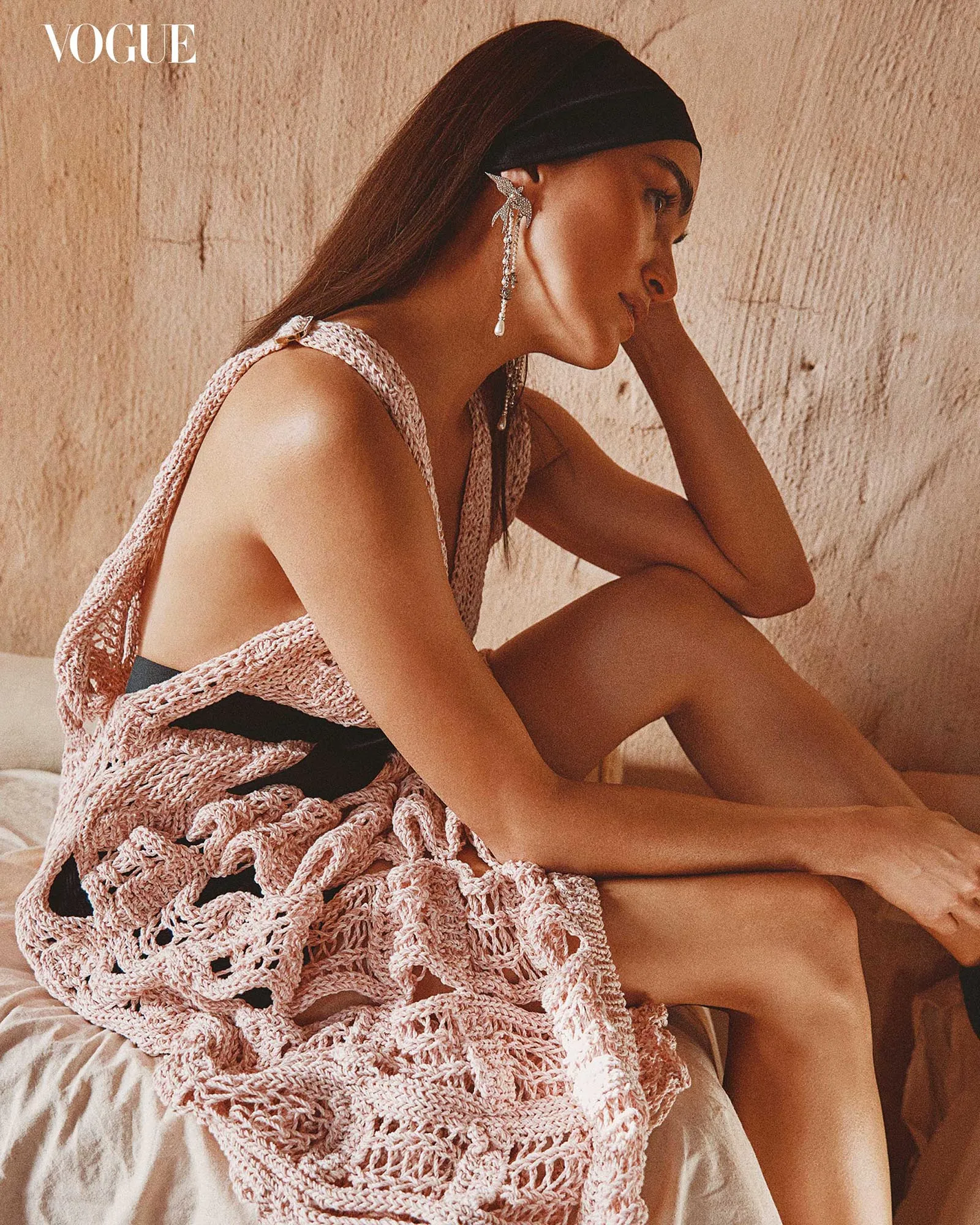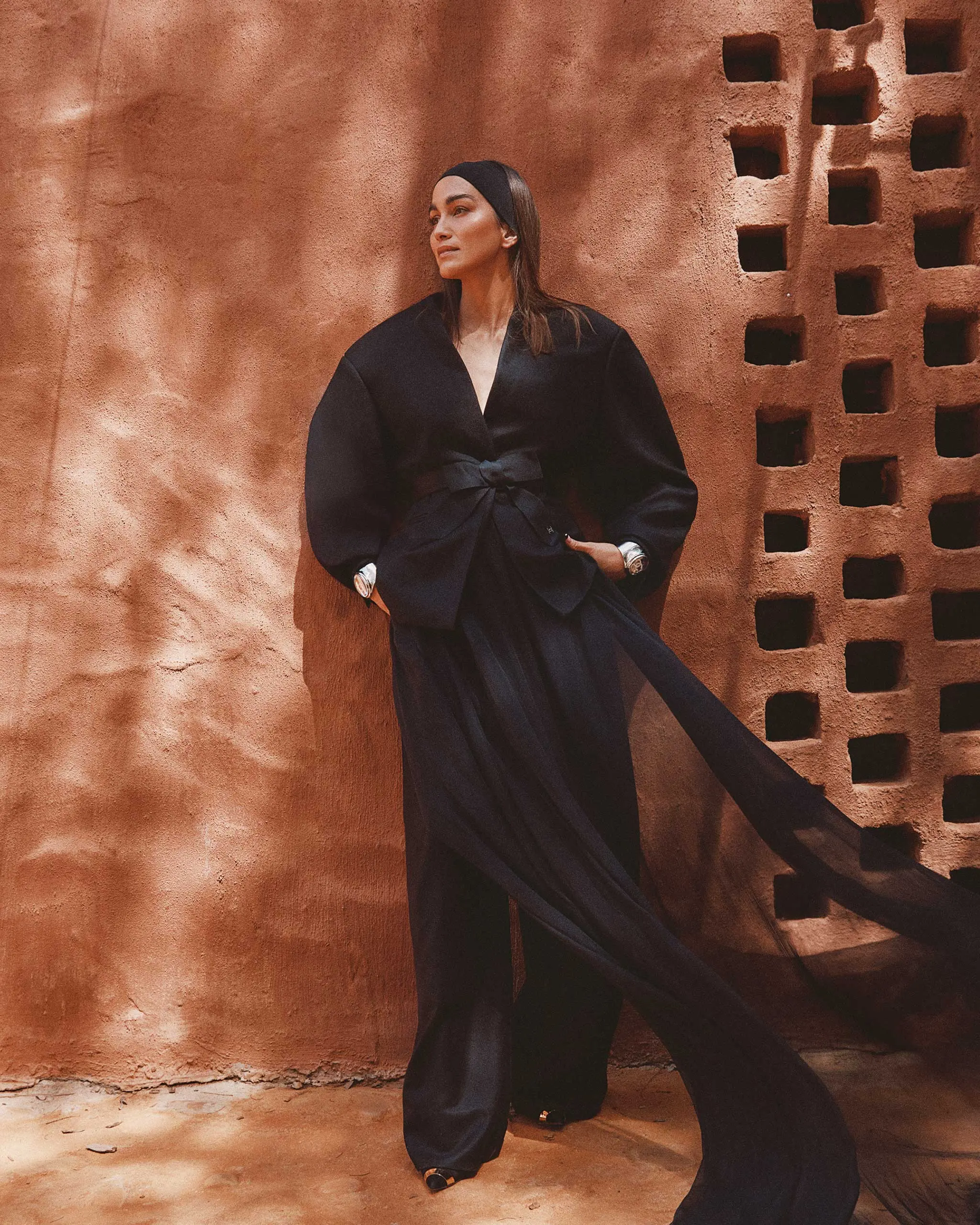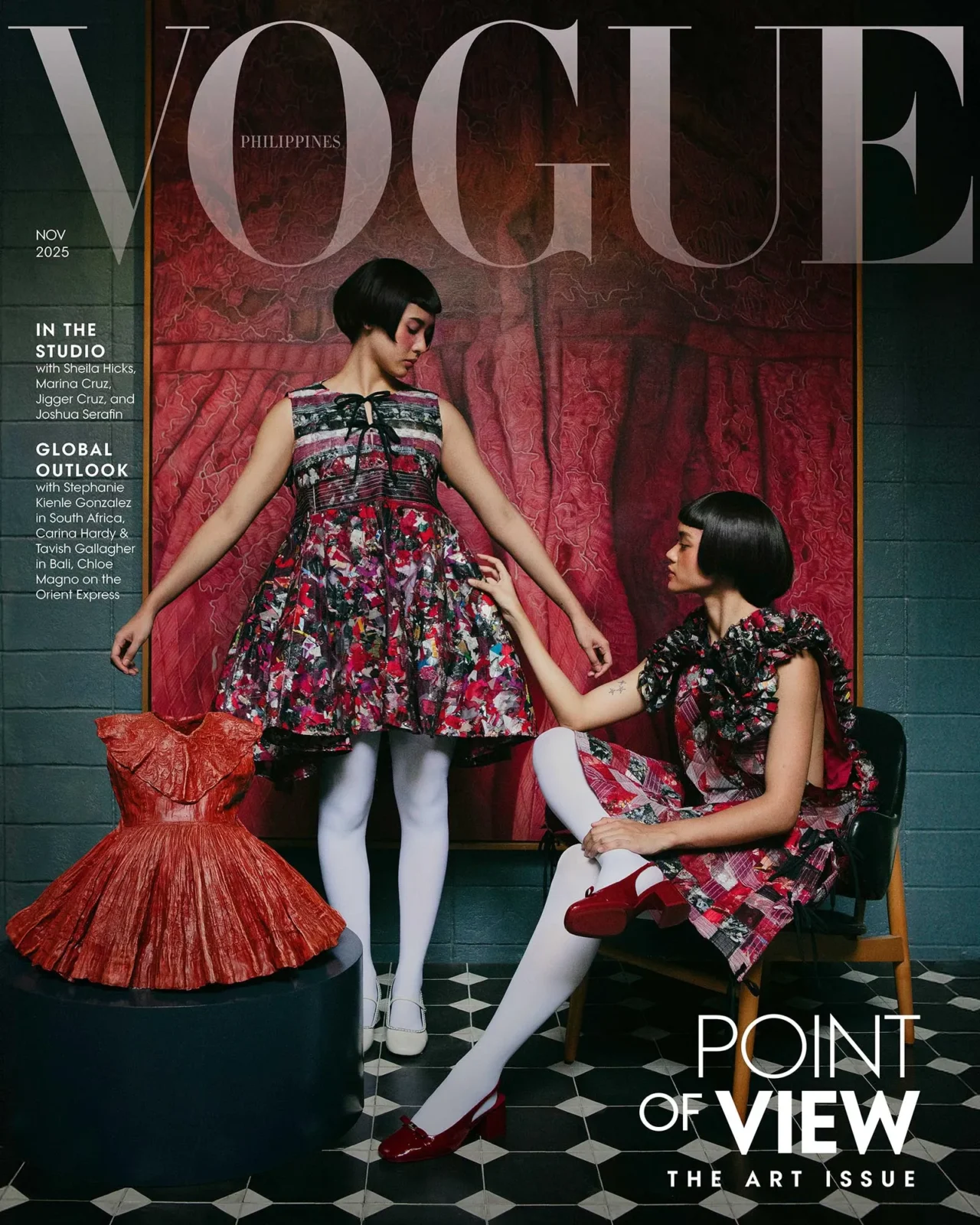Stephanie wears a NORMANDO blazer and trousers, CHANEL voile and bow worn as a belt, and GUISEPPE ZANOTTI shoes. Photographed by Ricardo Simal for the November 2025 Issue of Vogue Philippines
Over six months after their family’s move to South Africa, Stephanie Kienle Gonzalez reflects on the grounding power of change and nature.
Somewhere in Cape Town, the sprawling urban capital of South Africa, there is a 1920s arts and crafts heritage home that finally stands completely renovated after three years. The property is embraced by a lawn out front and a garden in the backyard, where flower beds are blooming with roses and dahlias, and vegetable crops abound: spring onions, celery, courgettes, artichokes, corn, and lettuce thrive in the sun. The hands behind this bounty are that of Andrea, Arielle, and Anouck, three young gardeners under the tutelage of their mother Stephanie Kienle Gonzalez, who, at least in this moment, is most proud of their peppers.
“We have a lot of sili,” Stephanie shares with a big smile. “So we made a big chili garlic oil pot for us, because we like things hot and spicy.”
Gonzalez, the president and managing director of furniture and lifestyle brand Philux, joins our call fresh from a morning of routines. She had just dropped off her kids at school and gone to the gym, and now, at 10 A.M. her time, sunlight streams generously into her office as she gushes about how she starts her days since moving to South Africa late last year. Clad in a lightweight black turtleneck sweater and simple gold hoop earrings, her slender fingers raise a mug to her lips every now and then, the only indication she’s still waking up.
Managing the business from abroad isn’t easy, but she’s figured out a schedule that works for her. It involves packed mornings to sync with the Philux team in Manila, so that by 6 P.M. in their zone, which is noon in hers, they’ve conducted all their meetings before the wind-down. Her afternoons, she says, are quieter in comparison.

This slower pace of life is what she and her husband Christian envisioned when they first toyed with the idea of a move. In hindsight, the decision to relocate unfolded naturally for the couple, who were fortunate enough to spend time in South Africa in the midst of the pandemic. Living in a high-rise Manila apartment, they yearned for more freedom during that uncertain period. So in 2021, the family found an opportunity to spend a combined total of three months in their Lapalala house (one they fondly call the Modumela House, which they built after stumbling upon the nature reserve in 2015).
That period served as “a powerful environmental awakening.” Stephanie recalls finding emotional, mental, and physical expansion as a result of immersing in the natural landscape, which “allowed for so much abundance for us and so much restorative time that it changed our lives.” It was then that she and Christian wondered, “‘How can we have more of this with our kids, while they’re at their prime ages of twelve, eight, and three?’ And that’s when we planted the seed of this idea of moving to South Africa.”
Gonzalez’s connection to the country runs deeply familial, with her father Max being a Swiss national born in the Democratic Republic of the Congo. In her book Embracing Natural Design, Stephanie writes, “My sister and I, both born and raised in Manila, have spent our lives shifting between European and Asian cultures because of family ties and close friends. My affinity for Africa was born out of my father’s childhood stories and has grown in recent years as I continue to explore the continent with my husband and children.”
“How can we have more of this with our kids, while they’re at their prime ages of twelve, eight, and three?”
As Stephanie and Christian conceptualized the move, their daughters’ education were among their top considerations. Wanting to marry their love for nature with the necessity of city life led them to the house in Cape Town: “We managed to stumble upon this home here, and we’re five minutes away from school.”
Although located in the City Bowl, the home was carefully designed to reflect the family’s advocacy for green living. It features a full solar panel system along with their own borehole, in order to keep their carbon footprint as low as possible. “I’m learning,” Stephanie confides, “because I’m used to apartment living in the Philippines, that a house always needs TLC. So these are all new things that I didn’t get to really learn how to manage in Manila.”
Over in Lapalala, their Modumela House is similarly eco-conscious. “It was built completely off the grid, using solar energy as the main source of power and incorporating other green elements, such as rain catchment containers and an evaporative cooling system,” Stephanie pens in her book. The bungalow was also built in red stone excavated from the hill on the property; it’s an effort to use as many local materials as possible, down to the stonework and the reed ceilings.
Of their home in the bush, she says, “It’s such a passion for our family because it opened our eyes to conservation, and it’s not just a holiday home for us. It’s a place where we can ground ourselves. We get to actually exchange with a lot of the scientists there, and so it’s also a learning experience for us and for my kids.”

In many ways, their new homestead gave the Gonzalez family exactly what they dreamt of, which is the luxury of slowing down and simply being more present. The constant flurry of Manila left Stephanie yearning for the chance to appreciate and savor “deeper pleasures and the subtleties of ordinary moments.” In her free time, she relishes quality time with their Weimaraner puppy named Otto, who she gets to walk up on the mountain nearby. “And we get to walk under Table Mountain, which is one of the wonders of the world. And when it’s a beautiful day, it’s a quick 30-minute or three, 4k walk, and I’m in fresh air. To me, it’s just so special to be able to do that from my doorstep.”
Over six months on, their biggest challenge is how the couple splits their time between Manila and Cape Town. The former will always be their first home, Stephanie emphasizes, and their families, friends, and businesses allow them to stay deeply connected to the archipelago. They’re still trying to find equilibrium amid the constant traveling (Stephanie tries to be in the Philippines every 10 to 12 weeks), but the memories they share together now have become more meaningful. “I would say we have more quality moments together, which I think is what our girls are going to remember. My girls, on the other hand, have transitioned so smoothly. Kids are very resilient, you know.”
She smiles, telling stories of how their daughters make new friends and find success in both academic and extracurricular activities. Andrea is in a high performance climbing team; Arielle plays tennis and was on the swim squad, and now she’s also doing rhythmic gymnastics with Anouck, their three-year-old. “It just shows that you can raise citizens of the world,” their mother muses. “They’re truly Filipino, but they’re also Swiss, they’re European. And now they’re living in Africa. I’m hoping it’ll really allow them to develop incredible empathy and an understanding of different cultures.”
Stephanie herself has had her taste of a nomadic life, having grown up in the Philippines and attaining degrees in economics, arts history, and marketing in New York, Paris, and London. “I feel so grateful to have been able to have that,” she intimates, before citing a translated Maasai proverb: “The eye that travels sees further.” It’s a philosophy she holds close, and one that resonates with her on varying levels.
“I’m hoping it’ll really allow them to develop incredible empathy and an understanding of different cultures.”
She considers, for example, how geographical and visual travel have brought her to Mexico, to meet the artist Fernando Laposse. In her office, mounted above the shelf bearing framed family photos, is a large artwork by Laposse made of native Mexican corn husks. “His work is all about advocating for the farmers in Mexico, and so he uses very humble materials like corn or avocado skins to create these beautiful, abstract kinds of work,” she explains. “My story with him was that I visited his studio, I learned about the purpose behind his art, and all of this kind of came together, and now this piece is sitting here behind my desk.”
She talks about journeying outside one’s comfort zone by seizing the moment, and she continues to explore even now, in her own ways, in Cape Town. She’s joined local dance classes and has taken up piano lessons again, all because “my dream is to be able to play the piano and sing at the same time, and do that with my girls.”
This sense of bright-eyed wonder, it seems, was passed down to her daughters. When they go for walks on the mountain, she often observes them observing nature. They notice birds, they notice insects, “A lot of that is what nature has been able to provide our family. A sense of grounding. This is a chapter in our life story at the moment,” Stephanie says, beaming. “And we’re gonna be taking it day by day.”
By TICIA ALMAZAN. Photographs by RICARDO SIMAL. Styling by ALEXANDRE DORNELLAS. Talent: Stephanie Kienle-Gonzalez. Hair and Makeup: Alet Viljoen. Fashion Production: Kaio Berguer and Fernanda Manduca. Fashion Assistants: Gabriela Dos Santos, Jamila Faba, and Joana Victoria. Photography Assistants: BruceHorak and Luke Stulinski. Videographer: Chris Glaze. Retouch: Fernanda Ronchi.
Special thanks to Kruijd by Kraak.

